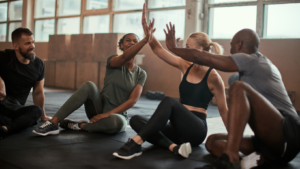At your local gym, you’ve likely encountered a colorful spectrum of personalities. From the dedicated bodybuilders to the early morning yoga enthusiasts, each person contributes to the unique culture of the fitness world. This article delves into the diverse universe of gym people, exploring the habits, quirks, and motivations that define them.
Gym People
 To understand the concept of gym people, one must delve deeper into their distinct characteristics and habits as well as the different types of gym enthusiasts each having a unique fitness approach and motivation.
To understand the concept of gym people, one must delve deeper into their distinct characteristics and habits as well as the different types of gym enthusiasts each having a unique fitness approach and motivation.
Gym people often display identifiable traits and routines. Regular attendance aligns with the gigantic motivation they pack for their fitness journey. They cultivate healthy habits, showing discipline not only within gym walls, but this extends broadly to their lifestyle – their diet, sleep routine, and more. For example, a true ‘gym person’ usually prioritizes a protein-rich diet and understands the importance of a good night’s sleep in muscle repair and growth.
The Role of Mindset in Fitness
The mindset is a powerful tool in the fitness journey of gym-goers, acting as their drive and sustainer in maintaining an active lifestyle.
Motivation Behind Regular Gym Visits
Going to the gym regularly isn’t just about physical strength; it’s about mental strength too. Gym-goers utilize goals and aspirations as key motivators. For some, it’s about maintaining a healthy lifestyle, for others, improving athletic performance or enhancing personal appearance might be the main drive. For instance, Weight Lifters often aim to break their own records, while Cardio Kings and Queens focus on enhancing their endurance levels.
Psychological Benefits of Exercise
 Exercise doesn’t just benefit the body, it offers immense psychological payoffs too. Regular physical activity positively impacts mental health, helping to reduce stress levels, improve mood, and boost overall well-being.
Exercise doesn’t just benefit the body, it offers immense psychological payoffs too. Regular physical activity positively impacts mental health, helping to reduce stress levels, improve mood, and boost overall well-being.
Research indicates that even moderate exercise can contribute to improved cognitive function, increased self-esteem, and a decrease in symptoms associated with anxiety and depression. For example, studies prove that endorphins released during exercise, often known as ‘runners high’, enhances mood and promotes a sense of relaxation.
Common Fitness Regimens Among Gym People
Strength Training Programs
Strength training programs form a crucial component of a gym-goer’s routine. These programs primarily involve lifting weights in various ways to build muscle mass and increase strength. The American College of Sports Medicine identifies strength training as a key component of overall health and fitness, recommending strength training exercises at least twice a week to every age group.
For example, Weight Lifters, who make up a significant portion of the gym population, focus on different types of strength training programs. These include compound exercises, such as squats and deadlifts, that work multiple muscle groups simultaneously. This approach allows them to gain muscle mass and enhance their overall strength significantly.
Cardiovascular Workouts
 On the flip side, Cardiovascular Workouts, or simply ‘cardio,’ form a large part of exercise routines for many gym-attendees, particularly the Cardio Kings and Queens. Regular cardio exercises, as the Mayo Clinic experts assert, aid in reducing the risk of heart disease, keeping weight under control, and enhancing mood by triggering the release of endorphins, the “feel good” hormones in the body.
On the flip side, Cardiovascular Workouts, or simply ‘cardio,’ form a large part of exercise routines for many gym-attendees, particularly the Cardio Kings and Queens. Regular cardio exercises, as the Mayo Clinic experts assert, aid in reducing the risk of heart disease, keeping weight under control, and enhancing mood by triggering the release of endorphins, the “feel good” hormones in the body.
Types of cardiovascular workouts range from high-intensity interval training (HIIT), which includes quick, intense bursts of activity to steady-state running or cycling. Some gym-goers combine a variety of cardiovascular exercises to maintain the excitement in their routines and challenge their bodies in different ways. This broad category of workouts contributes to the enhancement of cardiovascular health, weight management, and general fitness level.
Diverse Group With Different Goals
It’s apparent that gym people aren’t just a monolith of fitness enthusiasts. They’re a diverse group with different goals, methods, and tools to achieve their fitness objectives. The role of technology has become indisputable in shaping their journey. Fitness apps and wearables aren’t mere fads but essential tools that offer valuable insights and foster a sense of community.

